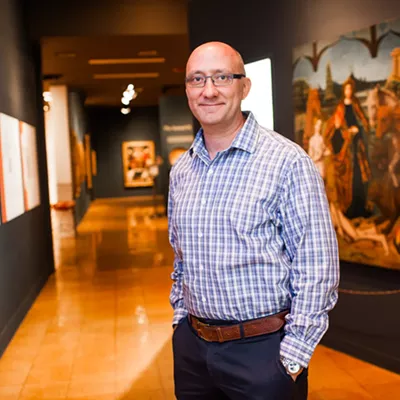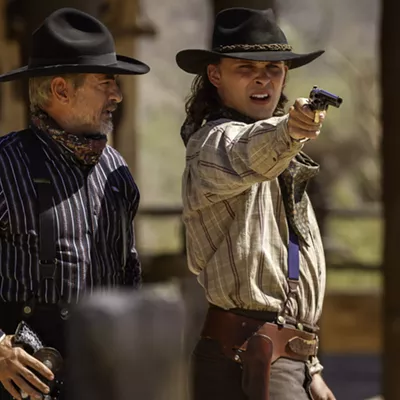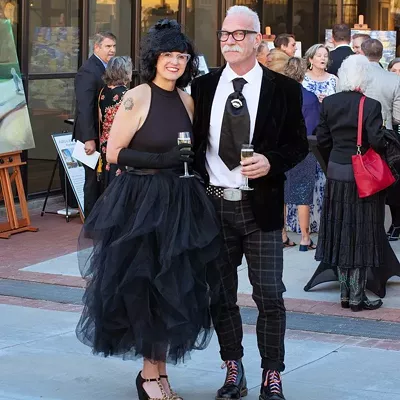Colin Chillag takes a camera with him wherever he goes.
Not, mind you, to shoot the sunburst sunsets of Phoenix, where he lives, or its towering mountains. No, he makes pictures of his daily life, the friends he hangs out with, the stores where he shops.
Then he turns these snapshots of the ordinary into paintings. Given his M.O., it's no surprise to find Circle K's, parking lots and gas pumps in his suite of deftly executed oils and acrylics at the University of Arizona Museum of Art, along with a painting of young people hanging by the pool.
Chillag is one of a quartet of artists in No Ordinary Place, a very contemporary show about personal geography organized by guest curator Brooke Grucella. Despite his cutting-edge cred, Chillag goes for a kind of realism in these pale images of places so familiar that we barely register them when we see them out in the world.
"7th Street and Roosevelt" shows a street corner occupied by the kind of store that tries its hardest to obliterate regional identity. The architecture of the Circle K is entirely disposable, but it's designed to be instantly recognizable, no matter where in the country you see it. Its red-and- white logo—the K inside the circle—beckons as bright a saint's halo, luring in devotees.
But in the distance, between the store and the gas pumps, you can see an older, far more distinctive place. Here Chillag slyly paints in some authentic vernacular Phoenix architecture: early 20th-century bungalows that are squat and square, pointy-roofed, and painted adobe and Southwest blue. Then there's the landscape even farther away, the low line of dusty blue mountains that you see almost wherever you turn in Arizona. And above is the great big Western sky, stripped of color by a heavy heat.
Like Chillag's four other paintings, "7th Street" is beautifully drawn and dramatically composed. The dull façade of the Circle K slices a striking diagonal across the white-hot sky. Its companion structure, the gas pump ramada, angles back in response.
Likewise, the young woman in bikini and tattoos in "Being Toward Others" has one arm slanting across an unfinished patio, and the legs of her unseen companions dart into the scene in another bold diagonal. The color of her peach flesh is echoed in the patio bricks.
But these paintings aren't only about daily life, Chillag's or otherwise. They're also musings on the nature of painting and art (and even, dare I say it, on the meaning of life).
"7th Street and Roosevelt" is painted normally over most of the canvas, with a nice swishy brushstroke reminiscent of Van Gogh's "Starry Night." But near the bottom, where the store meets the parking lot, the paint ends. Instead of oil on canvas, there's just a preliminary sketch, with pencil lines marking out where the parking lot's patches of concrete and asphalt will go. Above these bare spaces, the edges of the paint are jagged, almost writhing, struggling to exist. You almost start to wonder, is this a painting that was unfinished or a painting that's dissolving, about to disappear? Art is ephemeral, just as a city and its parts are.
In "I Love You a Little Bit More Every Day," another painting of another Circle K, the store is literally under a black cloud. It's disintegrating just like the companion K on Seventh Street, but it lays bare Chillag's process even more. The artist has penciled in notes to himself on the unpainted spaces, and he's turned his canvas into a literal palette, laying out his daubs of paint right on the canvas. He's allowed them to dry right there; they've become part of the finished art, contributing to Chillag's musings on change and chance.
The dark thundercloud that threatens the store may be more than a little metaphorical. Below it, Chillag has written in a wry timeline of the sweep of Western civilization. It begins with "The Battle of Hastings, 1066," gives way abruptly to "WWI" and "WWII" and then terminates at the era of Circle K. Is corporate domination and industrial food the inevitable end point of all that the human race has achieved so far? In this tongue-in-cheek vision, Chillag imagines this ordinary place, the red-and-white convenience store, as the endpoint of human achievement. Ouch.
Photographer and installation artist Matthew Moore is described as a fourth-generation farmer. In his installation, occupying an entire side room, some videos picture the carrots that the rich earth of his family's Arizona land yields. The gleaming orange skin of these veggies—and the deep black of the soil—make a nice contrast to the fake food of Chillag's convenience-store nation. But Moore's works are not only about food.
His handsome aerial photos track the encroachment of suburbia on formerly agricultural regions in the state. Interestingly, they also demonstrate that agriculture itself has little to do with wildness. Color C-print photos such as "Rotations: Moore Estates 2" show the artificial geometry of cultivated fields side by side with similarly laid-out suburban developments: farms and sprawl turn out to have much in common. Moore also creates his own gigantic installations, laying out long strips of mylar in the wilderness, creating outline "drawings" of future McMansions in the desert.
Kevin Cyr has imagined a less destructive—and much tinier—house in his "Little Tag Along," an arty fantasy of the perfect less-is-more dwelling. He's built a small-scale trailer out of plywood, plopped it on wheels and attached it to a bicycle. This little house, presiding over a good chunk of the exhibition's floor space, has everything a roaming human might need: a fold-out bed, a couple of cooking pots and matches, binoculars to allow the homeowner to commune with nature, a copy of Steinbeck's Travels with Charley and, of course, a mini-TV, to tether the traveler to civilization.
Carrie Marill also offers up a stripped-down aesthetic in "Doing a Lot with Very Little," a series of small gouache paintings of potted plants. Drawn from photos posted on an online Japanese architectural site, the spare plants, all angled branches and simple leaves, reflect Asian ideas of simplicity in design. And in the context of this show, they suggest that everybody could do more with less.












